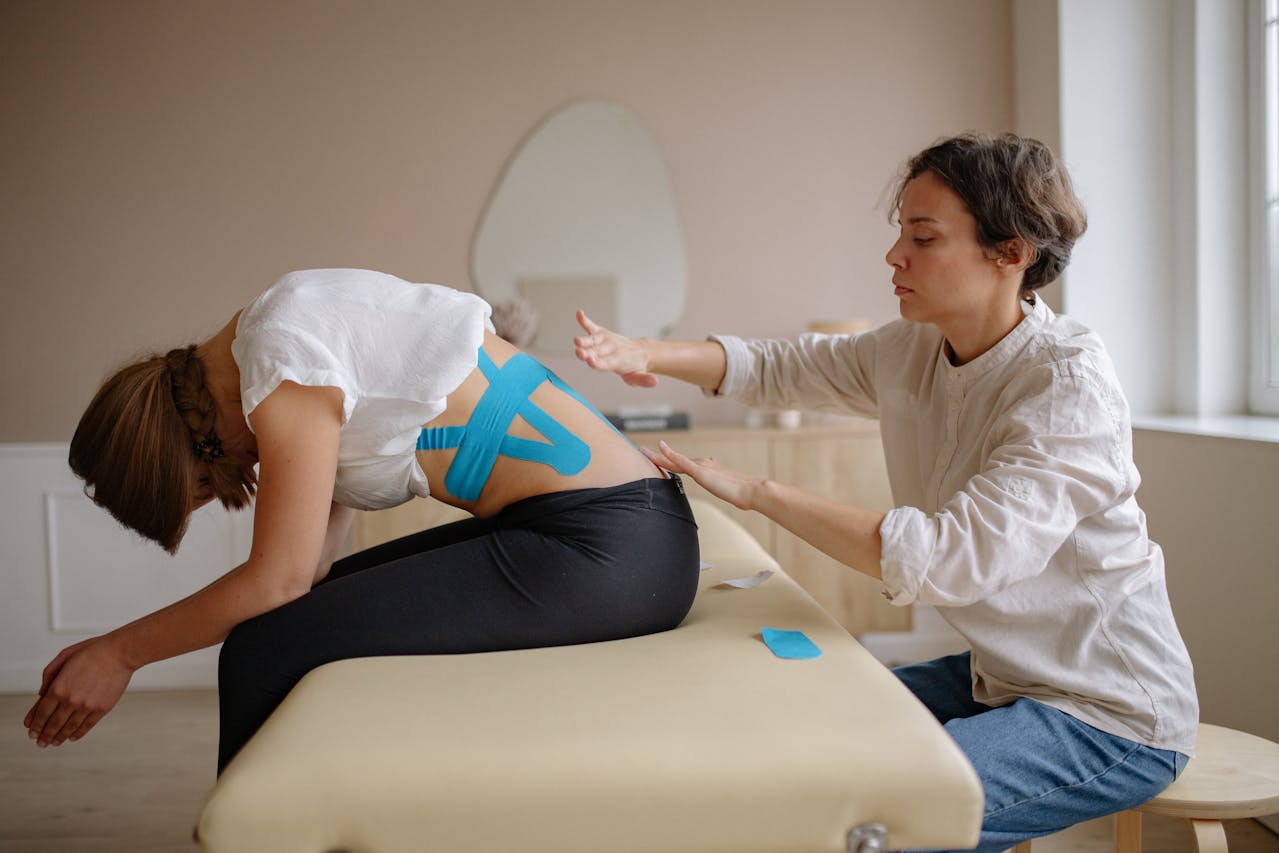
Table of Contents
Dive deep into lower back pain: its causes, symptoms, treatments, and prevention. Empower yourself with knowledge for a pain-free back.
Key Takeaways
- Definition: Lower back pain refers to discomfort in the lumbar region, ranging from dull aches to sharp sensations.
- Symptoms: Includes muscle aches, shooting or stabbing pain, and limited flexibility, sometimes accompanied by sciatica or leg pain. Severe pain may occur due to various conditions.
- Causes: Common causes include muscle strain, herniated discs, spinal stenosis, spinal canal issues, kidney stones, and rheumatoid arthritis.
- Diagnosis: Methods include physical exams, MRI, and bone scans.
- Treatments: Options range from physical therapy, massage, spinal manipulation to surgery, and lifestyle adjustments.
- Prevention: Maintaining a healthy weight, strong core, and good blood flow through regular exercise can help prevent lower back pain.
Lower back pain is a discomfort many of us will experience at some point in our lives. Yet, its familiarity doesn't make it any less challenging to understand or manage.
What is Lower Back Pain?
Lower back pain refers to any discomfort or ache localized in the lumbar region of the spine. It can range from a dull, constant ache to a sudden, sharp sensation, moving challenging.
Lower Back Vs. Upper Body Pain
While lower back pain focuses on the lumbar region, whereas upper body pain encompasses neck, shoulders, and upper spine discomfort, their causes, treatments, and prevention methods can differ, given the distinct functions and stresses on these areas.
How Common Is Chronic Low Back Pain
Chronic lower back pain persists for more than 12 weeks but is surprisingly common. Studies show that some adults may experience chronic back pain at some point, making understanding its origins and solutions imperative.
Symptoms and Types of Back Pain
Symptoms of lower back pain can vary greatly. They can include muscle aches, shooting or stabbing pains, limited flexibility, and an inability to stand straight. In some cases, the pain can radiate down one or both legs.
Acute Back Pain Vs. Chronic Back Pain
Acute back pain is short-term discomfort that lasts a few days to a few weeks. It's mostly mechanical in nature, often caused by trauma or misuse.
On the other hand, chronic back pain persists for 12 weeks or longer, even after an initial injury or underlying cause has been treated.
Sciatica Pain and Leg Pain
Conditions like sciatica, where the sciatic nerve is pinched, can cause pain radiating from the lower back into the legs and is considered one of the most common neurological disorders.
Leg weakness can also be a symptom of a herniated disk or spinal stenosis. Recognizing these interconnected symptoms can aid in quicker diagnosis and treatment.
Common Causes of Lower Back Pain
There's a myriad of reasons why one might experience lower back pain. While some are more frequent culprits, others can come as a surprise.
- Muscle strain: By far the most frequent cause of lower back pain, muscle strains occur when the muscle fibers are stretched or torn. This can result from lifting something improperly, sudden movements or overexerting oneself.
- Herniated disc: A herniated disc, often called a slipped or ruptured disc, happens when the soft center of a spinal disc pushes out through a crack in the tougher exterior. This can irritate nearby nerves, causing pain, numbness, or weakness in an arm or leg.
- Spinal stenosis: Spinal stenosis narrows the small spinal canal, which can compress and irritate the nerves inside. This condition can cause pain in the lower back and the legs, especially when walking.
- Kidney stones: Kidney stones are primarily known for causing extreme abdominal discomfort, but they can also lead to severe back pain, especially if the stones are located in the lower part of the kidneys.
- Rheumatoid arthritis: Rheumatoid arthritis, an autoimmune disorder, can cause joint pain throughout the body, including the spine. It can lead to persistent discomfort in the lower back area.
- Unexpected causes: Sudden impacts from car accidents can cause various back injuries, from strains and sprains to more severe spinal injuries. It's not uncommon for pain to appear days after the accident, emphasizing the need for medical checks after such incidents.
Anatomy and Physiology: The Back's Framework
The complexity of our back is a testament to its importance in our daily movements and overall health.
Lumbar Spine
The lumbar spine refers to the lower section of the spine between the diaphragm and the sacrum. It bears the weight of the body, playing a crucial role in our mobility and stability.
Spinal Cord and Spinal Nerves
The spinal cord acts as a relay center, transmitting messages between the brain and the rest of the body. Spinal nerves branch out from the spinal cord, carrying these messages to specific body parts.
Spinal Vertebrae, Spinal Joints, and Spinal Bones
These components form the robust and flexible frame that supports our body. Vertebrae are the individual bones stacked on each other; the joints allow for movement, and the spinal bones protect the spinal cord.
The Role Of Facet Joints and Spinal Disks
Facet joints connect the spinal vertebrae, aiding in the back's flexibility. Spinal disks act as shock absorbers between these vertebrae, ensuring smooth movements without bone-on-bone friction. They prevent injuries and ensure our spine's health and functionality.
Diagnosis and Testing
Before effective treatment can be prescribed, understanding the root cause of lower back pain is crucial. Here's a dive into the diagnostic methods doctors employ.
- Physical exam: This initial step involves a doctor checking for signs of nerve compression, muscle strength, and pain trigger points. Your doctor may ask you to perform specific movements to determine the pain's origin.
- Magnetic resonance imaging (MRI): An MRI provides a detailed image of the body's structures. For lower back pain, it can visualize disc herniation, muscle injuries, or spinal abnormalities that might be causing discomfort.
- Bone density test and bone scan: These tests measure the calcium content of bone, indicating bone strength and potential risk for fractures. A bone scan can also help detect problems like infections or fractures.
- Spinal laminectomy: A laminectomy, often called "decompression surgery," involves removing the back part of a vertebra that covers the spinal canal. It enlarges the spinal canal and is performed to relieve nerve compression.
Treatment Options for Lower Back Pain
A wide range of treatments are available, tailored to the specific causes and severity of the pain.
- Physical therapy: Physical therapy is the cornerstone for many back pain treatments. Therapists can teach postures, exercises, and stretches to help alleviate pain and prevent recurrence.
- Massage therapy can help relax and soothe muscles, improve blood flow, and release tension. It's a complementary method often used alongside other treatments.
- Spinal manipulation: Chiropractors and some doctors use spinal manipulation to adjust the spine. It can provide pain relief, especially for acute back pain.
- Spinal fusion: Spinal fusion permanently connects two or more vertebrae. It's a method to stabilize the spine, but it comes with risks and long recovery times.
- Surgery: For severe cases where non-surgical treatments don't help, surgeries like laminectomy or bone grafting may be recommended. These procedures aim to alleviate pressure or stabilize the spine.
- Alternative and complementary methods: Beyond conventional treatments, acupuncture, yoga, and biofeedback therapy have shown promise. It's essential to discuss any alternative treatments with a healthcare professional.
Self-care and Lifestyle Adjustments
Managing lower back pain often requires changes in daily routines and habits. These lifestyle modifications not only help in alleviating pain but can prevent its recurrence.
Maintaining a Healthy Weight
A healthy weight reduces the strain on your lower back. Excess weight, especially around the midsection, can shift the body's center of gravity and strain the lower spine. Regular exercise and a balanced diet can help in weight management.
Good Blood Flow
Proper circulation ensures essential nutrients reach the spine and toxins are removed. Activities like walking, stretching, and even certain dietary choices can promote better blood flow, aiding quicker healing and reducing pain.
Strong Core
The muscles in the abdomen play a crucial role in supporting the lower back. Core-strengthening exercises can provide more stability to the spine and reduce the likelihood of back pain.
Pain Management Techniques
Effective pain management is crucial for anyone with chronic or acute lower back pain. Here's a look into various methods to help control discomfort.
Holistic methods
Techniques like meditation, deep breathing, and visualization can aid in managing pain. These methods help divert the mind, reduce stress, and promote relaxation.
Medications and ointments:
Over-the-counter pain relievers, like ibuprofen or acetaminophen, can be effective for mild to moderate pain. Topical ointments and patches can offer relief at the source of pain. However, consulting with a healthcare professional before starting any medication is essential.
Frequently Asked Questions on Lower Back Pain
How Can I Relieve Lower Back Pain?
Relieving lower back pain symptoms often involves a combination of home remedies, medical treatments, and lifestyle changes.
Over-the-counter pain medications, applying heat or cold packs, and gentle exercises or stretches can be beneficial.
For chronic or severe pain, it might be necessary to consult with a healthcare professional who might suggest physical therapy, massage therapy, or other treatments.
Additionally, maintaining good posture, regular exercise, and managing stress can aid in alleviating and preventing back pain.
How Do I Know If My Lower Back Pain Is Serious?
While many instances of lower back pain can be attributed to minor injuries or muscle strain, certain symptoms could indicate a more serious condition.
These include pain that doesn't improve with rest, pain that radiates down one or both legs, weakness or numbness in legs, unexplained weight loss, fever, or pain after a trauma like a fall or accident.
If you experience any of these symptoms or if the pain persists for more than a few weeks, it's essential to consult a medical professional.
What Are The Three Common Causes Of Back Pain?
The three common causes of back pain are:
- Muscle or Ligament Strain: Repeated heavy lifting or sudden awkward movements can strain back muscles and spinal ligaments, leading to pain.
- Degenerative Disc Disease: With age, spinal discs lose their elasticity and cushioning capability, leading to pain.
- Herniated or Bulging Discs: When the soft inner portion of a disc protrudes through its outer ring, it can press on nerve roots, causing pain.
What Is The Fastest Way To Recover From Lower Back Pain?
Recovery from lower back pain involves a combination of treatments. Resting, but not for too long, can help.
Gentle movements and exercises can prevent stiffness and improve strength.
Physical therapy, maintaining a healthy weight, and practicing good posture can also expedite recovery.
For those with severe or chronic pain, consulting a healthcare professional will guide on the best recovery path tailored to individual needs.
References
Low Back Pain: Causes, Diagnosis & Treatments
Low Back Pain Pictures: Symptoms, Causes, Treatments .
Disclaimer
The contents of this article are provided for informational purposes only and are not intended to substitute for professional medical advice, diagnosis, or treatment. It is always recommended to consult with a qualified healthcare provider before making any health-related changes or if you have any questions or concerns about your health. Anahana is not liable for any errors, omissions, or consequences that may occur from using the information provided.

By: Anahana
The Anahana team of researchers, writers, topic experts, and computer scientists come together worldwide to create educational and practical wellbeing articles, courses, and technology. Experienced professionals in mental and physical health, meditation, yoga, pilates, and many other fields collaborate to make complex topics easy to understand.
